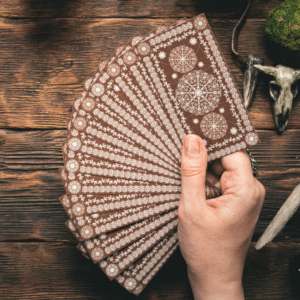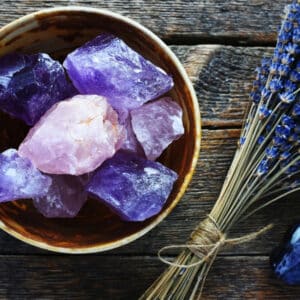We’ve compiled a guide to some beginner forms of divination, including chakras, palmistry, runes, and crystal pendulums.
This is by no means a complete list—there are divination methods used by ancient civilizations worldwide.
Some examples include:
- Ogham sticks rooted in Celtic traditions
- Bones used by the ancient Africans
- The Chinese book of changes (also called the i-ching)
- Bibliomancy
Some of these are easy to learn and even easier to use. Others are more involved. What’s certain is that there is a divination tool for every would-be seer.
Use this page and explore the basics of these methods to dig deeper into the energy of the Universe within you.
Navigate easily:
Your Beginners Guide to Chakras

Chakras are the energy centers of the body.
The chakras run up your spine from the tip of your coccyx (tailbone) to the top of your head. There are seven chakras, and each one resonates with a different color, a different music note, a different area of your body, and a different aspect of your life.
In the Sanskrit language, the word chakra translates to the word “wheel,” referring to the cyclical nature of revolving energy. When your chakras are open, energy can flow freely, and your body, mind, and spirit are fulfilled.
For you to be completely fulfilled and content with your life, your chakras must be aligned. If one or more of your chakras are unbalanced, the area of your life associated with them can get more complicated than necessary.
When you start to see issues arise, it’s time to work on your chakras!
The good news is that it’s not difficult to balance your chakras.
Reiki healing is one way—and if you work with color therapy or reiki healing stones, you’ll find this a fairly easy fix. Balancing your chakras is easy to learn, but the more you practice your chakra work, the more you’ll understand its benefits.
How to Balance the Chakras
It’s important to remember that even though not all of your chakras need a tuneup at once, you work with them all in turn.
Start with the Root chakra and work up to the crown, dealing with any imbalances you find along the way. The reason for this is that the Root chakra is the foundation for the seven chakras: if it’s wobbling, then the others are going to wobble, too.
Every chakra pulls energy up from the one below it. It stands to reason that if you try to balance the Crown chakra before you bring the others into alignment, then you’re going to be pulling up imbalanced energy.
However, that’s not to say that there’s only one way of working with chakras. There are advanced techniques that start at the top and work down, but when learning a new skill, it’s always best to master the basics, first. Chakra work is one of those things that take little time to learn, but a lifetime to master.
We’ve given some suggestions below to help you find balance, feel grounded, and realign your chakras.
The Root Chakra (Muladhara)
- Located at the base of the spine, it is also called the base chakra
- Associated with the color red
- Governs primal instincts and the will to survive
- Associated with the element of Earth
- Resonates with the etheric layer of the subtle body
- Vibrates to the music note “C”
- Rules the legs, feet, and bones
- Relates to the sense of smell
When your Root chakra is out of whack, you’ll feel unsettled. You’ll know you have a Root chakra imbalance when you are experiencing:
- Lower back pain could be a problem
- Fear that you won’t have everything you need to survive and thrive
- Trouble controlling your temper
- Trouble letting go of the past
On the other hand, when your Root chakra is balanced, you’re not worried about your life. Your overall health is good, and you live in the moment rather than clinging to the past. You’re happy with your work and feel content about how things are going.
To balance your Root chakra:
- Meditate on the color red
- Listen to music in the key of C
- Make sure you exercise and eat right
- Get a massage, particularly a foot massage
- Focus on the blessings in your life rather than what’s missing
The Sacral Chakra (Swadhisthanna)
- Located near the groin, below the belly button
- Corresponds to the sacrum in the spine
- Associated with the color orange
- Governs emotions and moods
- Associated with the element of Water
- Resonates with the emotional layer of the subtle body
- Vibrates to the music note “D”
- Rules hormones and reproductive organs
- Relates to the sense of taste
When your Sacral chakra is unaligned, you’ll feel restless and moody. Sexual issues may arise so that you cannot enjoy intimacy. You lose interest in looking after yourself. You oscillate between needing attention and shying away from it.
On the other hand, when your Sacral chakra is balanced, sex doesn’t inhibit you, and you aren’t obsessed with it. You’re able to ask for what you need and graciously receive it. You don’t have to be the center of attention, but if you’re put in the spotlight, you feel at ease. You’re confident, and your moods and emotions are balanced.
To balance your Sacral chakra:
- Meditate on the color orange
- Listen to music in the key of D
- Remember how to play and find fun—including sexual games with your partner
- Reconnect with your sense of self
- Explore your creativity
- Write out your heart’s desires so that you have a focal point to make them manifest
The Solar Plexus Chakra (Manipura)
- Located between the belly button and rib cage, also called the Navel chakra
- Associated with the color yellow
- Governs opinions and spiritual growth
- Associated with the element of Fire
- Resonates with the mental layer of the subtle body
- Vibrates to the music note “E”
- Rules the digestive system and metabolism
- Relates to the sense of sight
When your Solar Plexus chakra isn’t aligned, you’ll feel self-conscious and judgmental—towards others and critical of yourself. You become obsessed with your personal growth or develop a complete lack of interest in it. It’s easy for you to get bitter and frustrated with your life.
When your Solar Plexus chakra is balanced, you feel joyful about your life and what you’re accomplishing. You never play the victim, nor are you afraid of being rejected. There’s no need for you to criticize others, for you’re content with your life and easily able to focus on your goals.
To balance your Solar Plexus chakra:
- Meditate on the color yellow
- Listen to music in the key of E
- Spend time in the sunlight
- Add yellow fruits and vegetables to your diet
- Take the advice of a life coach, and actively participate in creating the person that you want to be
The Heart Chakra (Anahata)
- Located in the center of the chest, level with the heart
- Is considered the bridge between the upper and lower chakras
- Associated with the colors green or pink
- Governs compassion and unconditional love
- Associated with the element of Air
- Resonates with the astral layer of the subtle body
- Vibrates to the music note “F”
- Rules the heart, lungs, and respiratory system
- Relates to the sense of touch
- Meditate on the color green or pink
- Listen to music in the key of F
- Wear or hold Rose Quartz stones
- Give yourself new ways of looking at past hurts, so they no longer have a hold on you
- Find ways to experience joy
- Keep a gratitude journal
The Throat Chakra (Vishuddha)
- Located in the hollow of the throat
- First of the upper chakras
- Associated with the color blue
- Governs everything to do with communication
- Associated with the element of Ether
- Resonates with the etheric layer of the subtle body
- Vibrates to the music note “G”
- Rules the neck, mouth, and ears
- Relates to the sense of sound
It’s so easy to tell when your Throat chakra is out of sync because you’ll have trouble communicating. Your self-expression will be difficult. You’ll either not speak up, or you’ll say too much. You don’t hear what others are trying to convey. You overthink things.
When this chakra is functioning optimally, you’ll speak your truth appropriately and take the time to really hear others. Your body language is open, and you’re not afraid to be your authentic self. Your creativity flows, and it’s easy for you to express yourself, not just in what you say but also in your mannerisms and any form of art that you enjoy.
To balance your Throat chakra:
- Meditate on the color blue
- Listen to music in the key of G
- Sing, hum, or chant
- Study body language and learn how to pick up unspoken messages
- Keep a journal or a blog of your thoughts to help you organize them
The Third-Eye Chakra (Ajna)
- Located between the eyebrows, also called the Brow chakra
- Associated with the color indigo
- Governs eyesight, including clairvoyance, and psychic talents
- Associated with the element of light
- Resonates with the celestial layer of the subtle body
- Vibrates to the music note “A”
- Rules the eyes and intuition
- Relates to the sense of sight
This is often the most misunderstood chakra and easiest to recognize when it’s imbalanced. Egoism, a closed mind, delusion, and unrealistic aspirations indicate that this area needs work. Your mind jumps to all kinds of ideas and conclusions, mostly conjecture or fantasy.
When your Third Eye chakra is balanced, you’re balanced.
You have realistic goals, and you work hard to achieve them. You have wonderful ideas and plans, but you can discern what’s attainable and unrealistic. You’re in the world, but not of it. There are no unhealthy attachments.
To balance your Third-Eye chakra:
- Wear and meditate on the color indigo
- Listen to music in the key of A
- Spend time communicating with your authentic self
- Learn to trust your intuition
- Keep a dream diary to see what your unconscious is saying to you
The Crown Chakra (Sahasrara)
- Located at the top of the head, just above the hairline
- Associated with the colors violet and white
- Governs the understanding and your connection to your divinity
- Associated with the element of spirit
- Resonates with the causal layer of the subtle body
- Vibrates to the music note “B”
- Rules the brain and nervous system
- Relates to thinking and perception
When the Crown chakra is not performing at its peak, you feel separated, somehow. There’s no connection with any spiritual practice or beings. You feel disheartened and uninspired, or you take yourself too seriously and believe that you’re some kind of divine savior.
When this chakra is aligned, you know who you are. You know what you’re capable of doing, and you’re working at making that happen. You’re at peace with your world, and your faith is strong. You accept yourself as you are, and you can be generous with your time and talents.
To balance the Crown chakra:
- Practice breathing exercises
- Wear or hold crystals that are the color purple
- Listen to music in the key of B
- Immerse yourself in spiritual pursuits
- Take up exercises—like yoga or Tai Chi—that blends the physical with the spiritual
- Use meditation and prayer as your best allies
Palm Reading

Have you ever been fascinated by the lines on your palms? You are not alone. Palmistry has intrigued many for centuries as a way to further explore one’s personality.
Palmistry, also known as chiromancy, is a respected form of divination where palm readers use the markings on our palms, the shape of our hands, and the length of the fingers (among other qualities) to reveal information about individual’s personalities and even to predict future events.
While the history of palmistry is unclear, it’s been used for centuries as anything from a parlor game to a very intense interpretation of one’s life and spiritual progress. Both palmistry and the Tarot have their roots in astrology, as the lines and mounds on your dominant and non-dominant hand have names that directly relate to the planets and celestial orbs. How these lines and mounds form makes your own palm completely unique from everyone else.
A complete interpretation of palmistry is divided into several different sections:
- Overall hand shapes
- The length and shape of the fingers
- The lines on the palm
- The whorls at the fingertips
- The fleshy part at the base of the fingers
- The dip in the middle of the palm
- The length and shape of the thumb
- The lines around the wrist
These all tell a tale—and to get the full story, both palms need to be examined.
When you think of a palm reading, you probably think of having the lines on your hand interpreted, and you’d be right, but that’s not the whole picture. The lines do reveal a lot, though.
There are four main lines to look at:
- The head line
- The heart line
- The life line
- The fate line
Not everyone has a fate line (and no, that doesn’t mean they don’t have a destiny). These lines can have other lines connected to them or braided through them. The way that these lines present themselves reveals a lot about your personality and events in your life.
The fingers of the hand are given names of the planets:
It’s easy to see the astrological associations there!
The fleshy bumps under the fingers are given the same correlations. The bump under the pinky finger is the Mount of Mercury, the one under the ring finger is the Mount of the Sun (and this mount and finger are sometimes referred to as Apollo, rather than the Sun), and so forth.
The thumb is treated rather differently—it’s not interpreted with the rest of the fingers but it is given it’s own set of characteristics and meanings. It is not associated with a planet, although the big fleshy part of your hand where the thumb joins it before going into your wrist is called the Mount of Venus. The big fleshy part opposite that is called the Mount of the Moon. The dip in the middle of your palm is referred to as the Plane of Mars. This also has two smaller areas; Upper Mars is to the left of the Mount of Mercury, and Lower Mars is between the index finger and the thumb.
Palmistry is both an intricate and a fascinating study. Like so many divination tools, it’s something that is easy to pick up. All you need is a palmistry guide and a pair of hands!
The more you learn and practice reading people’s hands, the more nuances you’ll discover, and the more fascinating the art of chiromancy becomes.
Crystal Pendulums

No introduction to divination would be complete without looking at dowsing, and in particular, pendulums.
Looking for things with a pendulum is called dowsing, and people dowse for many different things. Have you ever seen someone using a forked stick, or two L-shaped metal rods, looking for water? That’s dowsing. You could use a pendulum for that, too, and so much more!
Pendulum power can be used for:
- Contacting spirits.
- Answering questions.
- Determining where to place furniture or bed a plant.
- Choosing what to eat.
- Finding weak spots in your energy.
Crystal pendulums can be a huge asset when making daily decisions. They bring you a glimpse of other people’s viewpoints and help you to strengthen your connection with your guides. They’ll also allow you to understand yourself much more deeply.
Pendulums are small and discreet, and you don’t have to be some kind of elder or sage to use one. It will talk to you as soon as you start to talk to it! You do have to take it seriously, though, and learn the way in which it communicates.
We recommend you use a chakra pendulum.
Why?
Well, the color sequence is balanced, and the quartz tip is receptive. The overall stone is green—the color of the Heart chakra—so it’s gentle and non-judgmental. The colors in the pendulum mirror the colors of your chakras that run up and down your spine. When those are out of whack, you’re going to be off-balance. A pendulum helps you to identify that imbalance and bring it back into alignment.
How to Use a Crystal Pendulum
If you use Tarot, runes, or crystals, the pendulum will pick them for you. Just hold it firmly over the cards or stones and wait until it stops swinging. Then you’ve determined that’s the one to pick.
Your pendulum isn’t limited to healing or divination, though. It has the potential to be a wonderful advisor for more mundane things in your life.
The list is endless, but you might try:
- Holding it over a map when looking to move houses or change jobs.
- Dangling it over a menu to decide what to order.
- Suspending it over your calendar when determining the right dates for appointments.
- Using it over photographs of potential partners to see if they’re going to be worth your time.
On the other hand, it’s a bit more complicated to use the pendulum for palmistry because it’s often hard to hold both hands steady. One way is to use a photograph of your hand or a chart that illustrates the different lines and mounds.
Where the pendulum points is where your focus falls.
You can also hold your pendulum over an illustration of your chakras to determine which one needs tuning.
Runes

Runes are possibly one of the most enigmatic and mysterious divination tools. The word rune comes from the Norse word “runa,” which means “secret,” but no one really knows the exact history of runes, or what they were used for.
What we do know is that:
- There are many different types of runes.
- Most people think of the Viking runes when they think of runes and rune stones.
- The most popular version is called the Elder Futhark.
- They are based on the old Norse alphabet.
When we discuss runes, we’re referring to the Elder Futhark.
Like the Tarot, there’s a set natural presentation for the stones. In fact, the Elder Futhark gets its name from the first letter of each stone in the first Aett, or line, of the stones as they’re laid out in their proper order.
Just as you’d shuffle Tarot cards before doing a layout, you’ll also mix up your rune stones—usually by putting them in a bag and shaking it before you draw out the stones one at a time. Then you’ll place them in the positions of the spread you’re using and start to interpret their meanings.
Unfortunately, runes aren’t usually quite as kind as the Tarot when it comes to their meanings—many of them are cold and quite severe.
There’s also less room for speculation with runes. Whereas the images on the Tarot might relate to many things, this is not the case with runes. Some of them mean the same upside down as they do right side up because of the pattern in the glyph.
There are slight variations between the sets of the Elder Futhark. Some contain a blank rune, but this is a modern addition—one that serious runesters mock. There are differences in the style of the staves, with some being more curved or elongated than others.
There are also some differences in pronunciation, which could be attributed to the different Nordic dialects. The most drastic difference is that sometimes the order of the last two runes in the third aett is switched. There’s no established right or wrong way. It’s up to the runester to discern.
Runes can be made of many different materials:
- Disks of wood where the symbols are burned or painted on.
- Small stones.
- Flat glass marbles that are used in floral displays.
- Polymer clay runes that are hardwearing and easy to make.
- Semi-precious stones, like amethyst, carnelian, or rose quartz where the symbols are laser engraved.
For people who are serious about embracing the mystical side of life, gemstones are used because the energetic properties of these stones are passed on to the symbols.
For example, amethyst is a gentle and spiritual stone. It’s believed that runes carved into amethyst might have gentler energy and give a less harsh reading than runes on a more somber material.
Try pulling out one stone for a quick reading to get an immediate snapshot of what’s going on in any particular situation. You might want to make a special bag or box in which to keep the stones when they’re not in use.
Like any other tool, it’s up to you to find your own way of working with them. You’ll be surprised at what they have to say.




